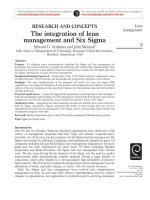The architecture of computer hardware and systems software an information technology approach ch05
Bạn đang xem bản rút gọn của tài liệu. Xem và tải ngay bản đầy đủ của tài liệu tại đây (197.42 KB, 27 trang )
CHAPTER 5:
Floating Point Numbers
The Architecture of Computer Hardware and
Systems Software:
An Information Technology Approach
3rd Edition, Irv Englander
John Wiley and Sons 2003
Floating Point Numbers
Real numbers
Used in computer when the number
Is outside the integer range of the
computer (too large or too small)
Contains a decimal fraction
Chapter 5 Floating Point
Numbers
5-2
Exponential Notation
Also called scientific notation
12345
12345 x 100
0.12345 x 105
123450000 x 10-4
4 specifications required for a number
1.
2.
3.
4.
Sign (“+” in example)
Magnitude or mantissa (12345)
Sign of the exponent (“+” in 105)
Magnitude of the exponent (5)
Plus
5. Base of the exponent (10)
6. Location of decimal point (or other base) radix point
Chapter 5 Floating Point
Numbers
5-3
Summary of Rules
Sign of the mantissa
Sign of the exponent
-0.35790 x 10-6
Location
of decimal
point
Mantissa
Chapter 5 Floating Point
Numbers
Base
Exponent
5-4
Format Specification
Predefined format, usually in 8 bits
Increased range of values (two digits of
exponent) traded for decreased precision
(two digits of mantissa)
Sign of the mantissa
SEEMMMMM
2-digit Exponent
Chapter 5 Floating Point
Numbers
5-digit Mantissa
5-5
Format
Mantissa: sign digit in sign-magnitude format
Assume decimal point located at beginning of
mantissa
Excess-N notation: Complementary notation
Pick middle value as offset where N is the
middle value
Representation
0
49
50
99
Exponent being
represented
-50
-1
0
49
Increasing value
+
Chapter 5 Floating Point
Numbers
–
5-6
Overflow and Underflow
Possible for the number to be too large or too
small for representation
Chapter 5 Floating Point
Numbers
5-7
Conversion Examples
05324567 =
0.24567 x 103
=
246.57
54810000 = – 0.10000 X 10-2 = – 0.0010000
5555555
= – 0.55555 x 105 =
04925000 =
0.25000 x 10-1
Chapter 5 Floating Point
Numbers
=
– 55555
0.025000
5-8
Normalization
Shift numbers left by increasing the exponent
until leading zeros eliminated
Converting decimal number into standard
format
1. Provide number with exponent (0 if not yet
specified)
2. Increase/decrease exponent to shift decimal point
to proper position
3. Decrease exponent to eliminate leading zeros on
mantissa
4. Correct precision by adding 0’s or
discarding/rounding least significant digits
Chapter 5 Floating Point
Numbers
5-9
Example 1: 246.8035
1. Add exponent
246.8035 x 100
2. Position decimal point
3. Already normalized
.2468035 x 103
4. Cut to 5 digits
5. Convert number
.24680 x 103
05324680
Sign
Excess-50 exponent
Chapter 5 Floating Point
Numbers
Mantissa
5-10
Example 2: 1255 x 10
1. Already in exponential form
-3
1255x 10-3
2. Position decimal point
3. Already normalized
0.1255 x 10+1
4. Add 0 for 5 digits
0.1255 x 10+1
5. Convert number
05112550
Chapter 5 Floating Point
Numbers
5-11
Example 3: - 0.00000075
1. Exponential notation
2. Decimal point in position
3. Normalizing
- 0.00000075 x 100
- 0.75 x 10-6
4. Add 0 for 5 digits
- 0.75000 x 10-6
5. Convert number
154475000
Chapter 5 Floating Point
Numbers
5-12
Programming Example: Convert Decimal
Numbers to Floating Point Format
Function ConverToFloat():
//variables used:
Real decimalin; //decimal number to be converted
//components of the output
Integer sign, exponent, integremantissa;
Float mantissa; //used for normalization
Integer floatout; //final form of out put
{
if (decimalin == 0.01) floatout = 0;
else {
if (decimal > 0.01) sign = 0
else sign = 50000000;
exponent = 50;
StandardizeNumber;
floatout = sign = exponent * 100000 + integermantissa;
} // end else
Chapter 5 Floating Point
Numbers
5-13
Programming Example: Convert Decimal
Numbers to Floating Point Format, cont.
Function StandardizeNumber( ): {
mantissa = abs (mantissa);
//adjust the decimal to fall between 0.1 and 1.0).
while (mantissa >= 1.00){
mantissa = mantissa / 10.0;
} // end while
while (mantissa < 0.1) {
mantissa = mantissa * 10.0;
exponent = exponent – 1;
} // end while
integermantissa = round (10000.0 * mantissa)
} // end function StandardizeNumber
} // end ConverToFloat
Chapter 5 Floating Point
Numbers
5-14
Floating Point Calculations
Addition and subtraction
Exponent and mantissa treated separately
Exponents of numbers must agree
Align decimal points
Least significant digits may be lost
Mantissa overflow requires exponent again
shifted right
Chapter 5 Floating Point
Numbers
5-15
Addition and Subtraction
Add 2 floating point numbers
05199520
+ 04967850
Align exponents
05199520
0510067850
Add mantissas; (1) indicates a carry
(1)0019850
Carry requires right shift
05210019(850)
Round
05210020
Check results
05199520 = 0.99520 x 101
=
04967850 = 0.67850 x 101 =
9.9520
0.06785
= 10.01985
In exponential form
Chapter 5 Floating Point
Numbers
= 0.1001985 x 102
5-16
Multiplication and Division
Mantissas: multiplied or divided
Exponents: added or subtracted
Normalization necessary to
Restore location of decimal point
Maintain precision of the result
Adjust excess value since added twice
Example: 2 numbers with exponent = 3
represented in excess-50 notation
53 + 53 =106
Since 50 added twice, subtract: 106 – 50 =56
Chapter 5 Floating Point
Numbers
5-17
Multiplication and Division
Maintaining precision:
Normalizing and rounding multiplication
Multiply 2 numbers
x
05220000
04712500
Add exponents, subtract offset
52 + 47 – 50 = 49
Multiply mantissas
Normalize the results
04825000
Round
05210020
Check results
0.20000 x 0.12500 = 0.025000000
05220000 = 0.20000 x 102
04712500 = 0.125 x 10-3
= 0.0250000000 x 10-1
Normalizing and rounding
=
Chapter 5 Floating Point
Numbers
0.25000 x 10-2
5-18
Floating Point in the Computer
Typical floating point format
32 bits provide range ~10-38 to 10+38
8-bit exponent = 256 levels
Excess-128 notation
23/24 bits of mantissa: approximately 7 decimal
digits of precision
Chapter 5 Floating Point
Numbers
5-19
Floating Point in the Computer
Excess-128 exponent
Sign of mantissa
Mantissa
0
1100 1100 0000 0000 0000 000 =
1000 0001
+1.1001 1000 0000 0000 00
1
1000 0100
1000 0111 1000 0000 0000 000
-1000.0111 1000 0000 0000 000
1
0111 1110
1010 1010 1010 1010 10101 101
-0.0010 1010 1010 1010 1010 1
Chapter 5 Floating Point
Numbers
5-20
IEEE 754 Standard
Precision
Single
(32 bit)
Double
(64 bit)
Sign
1 bit
1 bit
Exponent
8 bits
11 bits
Excess-127
Excess-1023
2
2
2-126 to 2127
2-1022 to 21023
Mantissa
23
52
Decimal digits
≈ 7
≈ 15
≈ 10-45 to 1038
≈ 10-300 to
10300
Notation
Implied base
Range
Value range
Chapter 5 Floating Point
Numbers
5-21
IEEE 754 Standard
32-bit Floating Point Value Definition
Exponent
Mantissa
Value
0
±0
0
0
Not 0
±2-126 x 0.M
1-254
Any
±2-127 x 1.M
255
±0
±∞
255
not 0
special condition
Chapter 5 Floating Point
Numbers
5-22
Conversion: Base 10 and Base 2
Two steps
Whole and fractional parts of numbers with
an embedded decimal or binary point must
be converted separately
Numbers in exponential form must be
reduced to a pure decimal or binary mixed
number or fraction before the conversion
can be performed
Chapter 5 Floating Point
Numbers
5-23
Conversion: Base 10 and Base 2
Convert 253.7510 to binary floating point form
Multiply number by 100 25375
Convert to binary
110 0011 0001 1111 or 1.1000
equivalent
1100 0111 11 x 214
IEEE Representation
Sign
0 10001101 10001100011111
Excess-127
Exponent = 127 + 14
Mantissa
Divide by binary floating point equivalent of 10010 to
restore original decimal value
Chapter 5 Floating Point
Numbers
5-24
Packed Decimal Format
Real numbers representing dollars and cents
Support by business-oriented languages like
COBOL
IBM System 370/390 and Compaq Alpha
Chapter 5 Floating Point
Numbers
5-25









